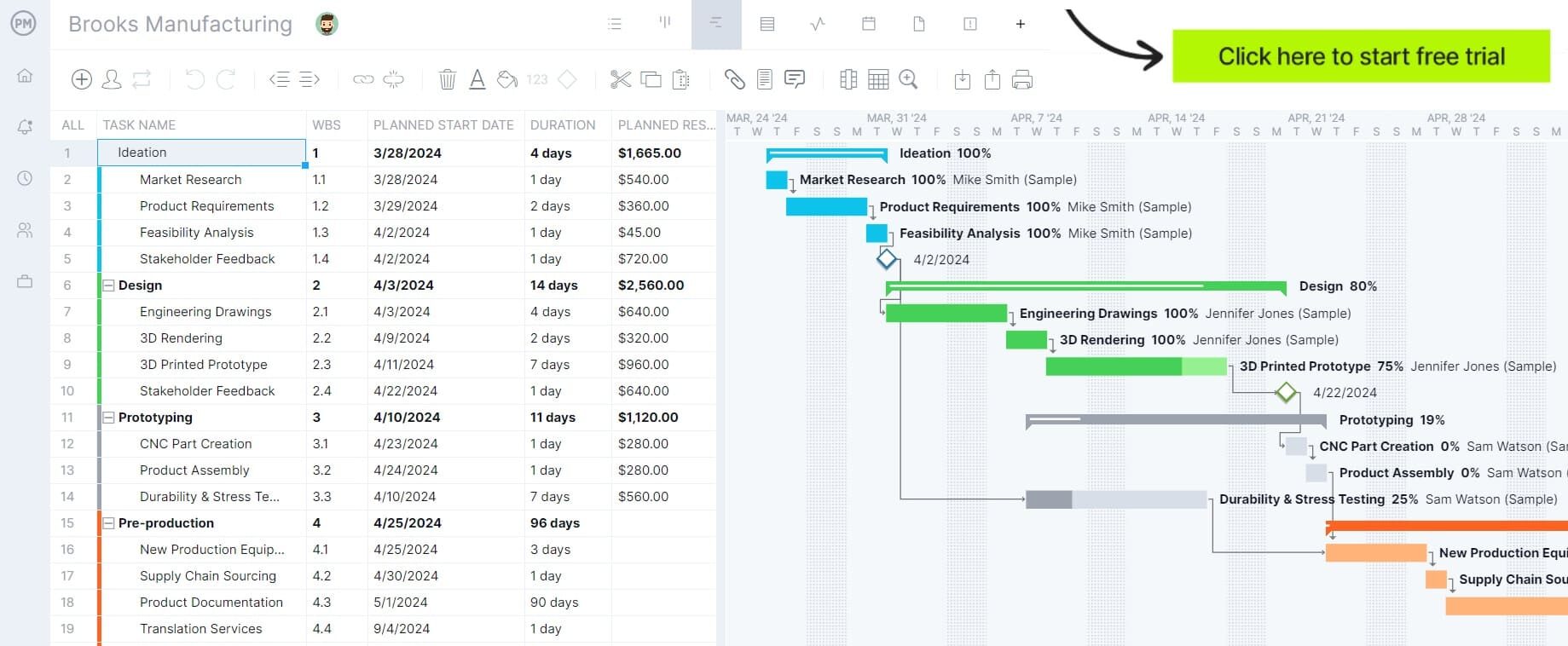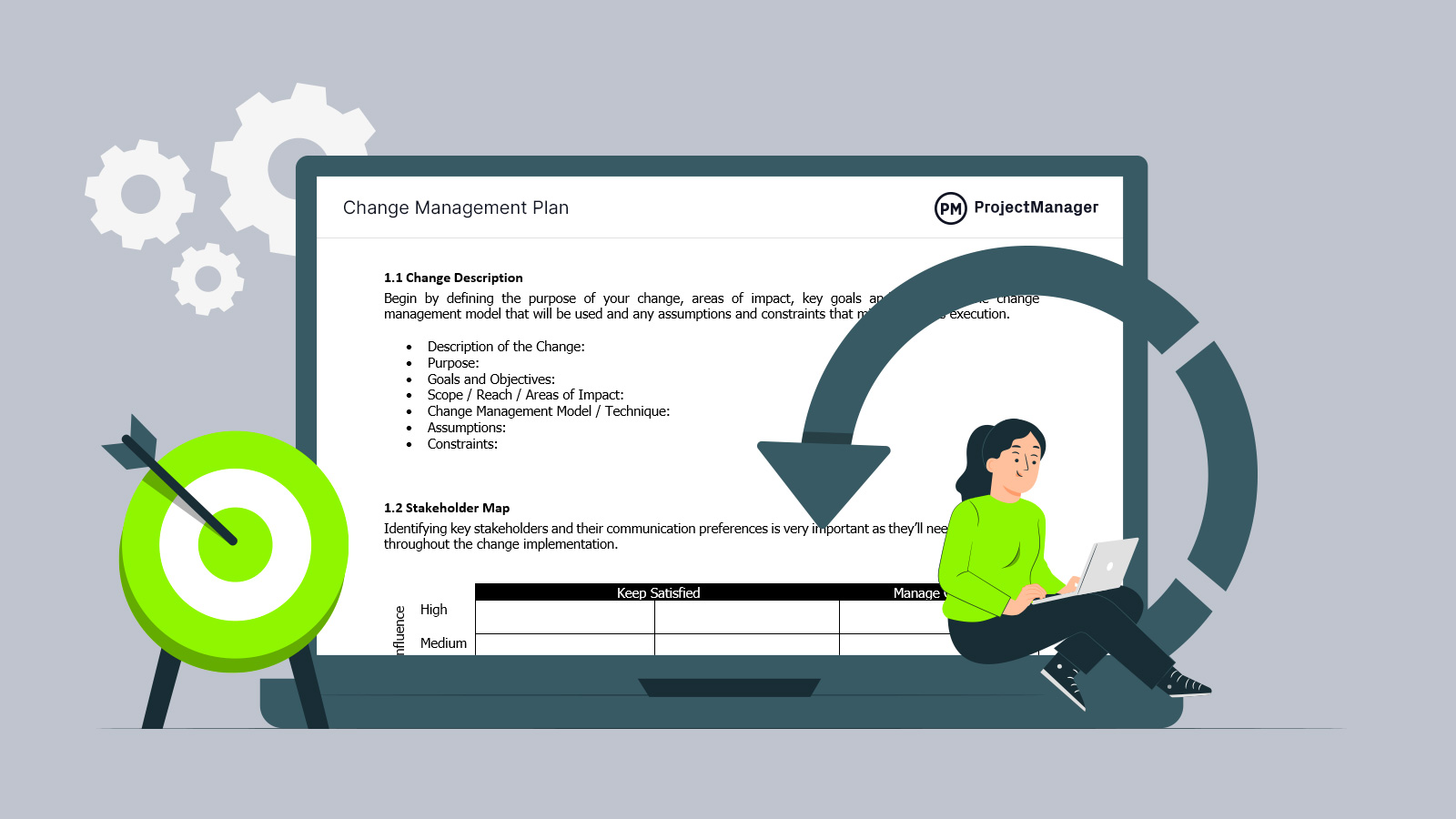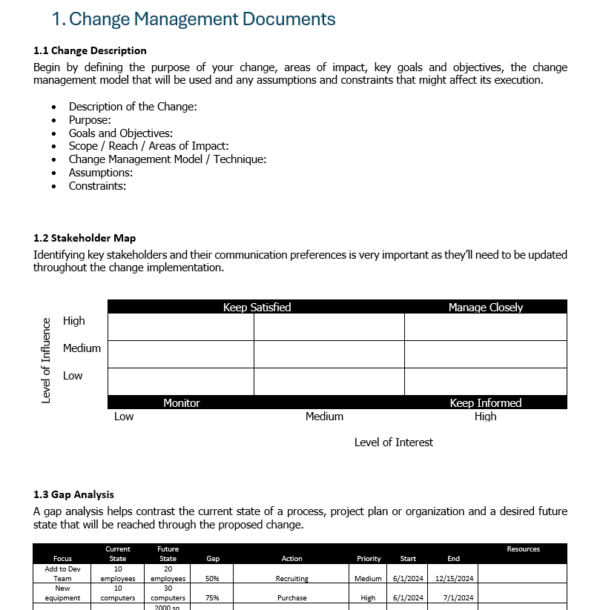One thing is certain: change will happen in your organization or project. To best plan and respond to change, first, a clear definition of change management must be understood.
What Is Change Management?
Change management refers to the actions, tools and models implemented to manage different types of change either at the project or organizational level. Several organizational change management strategies can be applied to manage work, resources, business processes and budget allocations as well as different types of organizational changes.
At the project level, you’ll need to set up a change management strategy or framework that guarantees that all changes to the project plan are properly approved, implemented and tracked so that the project timeline, budget or resources are not affected by any sudden changes made to the initial scope, schedule or budget baseline.
ProjectManager helps you make a change management plan and track it in real time, whether you’re managing project changes or organizational changes. Set up the plan with our robust Gantt charts, which populate the plan on a visual timeline so you can see it all in one place. Add resources, tasks, durations, milestones and task dependencies. Get started with ProjectManager today for free.

What Is a Change Management Strategy?
A change management strategy is a set of procedures, documentation and guidelines organizations use to plan and execute changes. The two most important elements of any change management strategy are the change plan and change control board.
The change plan, or change management plan is a document that describes the change management strategy in detail while the change control board is a group of key employees and subject matter experts who approve change requests in an organization or project.
Main Types of Change Management
Here’s a quick overview of the most common types of change projects and organizations face.
- Project change management: In project management, changes must be thoroughly documented and approved so resources and time can be allocated for their implementation. If any changes are made to the project plan without supervision they will impact the budget and schedule. To avoid this you’ll need to establish a system to approve change order requests presented by project team members or stakeholders.
- Strategic change management: Organizations often make changes to their business strategy which may include initiatives like offering new products or services, targeting new markets or opening new business units. Such strategic changes usually affect every layer of the organization and require a high level of organizational change readiness.
- Structural change management: The organizational structure of a business, nonprofit or government agency refers to the hierarchical structure in which employees and teams are distributed across an organization, allowing it to operate. Sometimes, this structure needs to be changed by taking actions like adding or subtracting functional areas, laying off employees or opening new positions.
- Technological change management: Certain industries such as manufacturing are constantly implementing new technologies. However, doing so requires planning a change management strategy that will minimize resistance to change and facilitate the adoption of new tools.
- Cultural change management: Changing certain aspects of the organizational culture may impact the employee’s compensation, work conditions or everyday routine.

Get your free
Change Management Plan
Use this free Change Management Plan for Word to manage your projects better.
What Is the Importance of Change Management?
Establishing a change management framework is one of the most important things to do when managing a project or organization. There are two main reasons for this. First, organizations need change to adapt to unexpected scenarios such as ever-changing markets, economies and technology.
Secondly, changes can positively and negatively impact projects and organizations so they should always be thoroughly planned for.
Change Management Examples
These real-life change management examples from across industries help illustrate the different types of changes.
- Construction: Clients commonly ask contractors to expand the scope of work for a construction project to execute more tasks as they come up with additional features for their building as the project is in progress. In this case, the owner should assume additional costs and expect a delay in the completion date as this wasn’t included in the construction plan.
- Manufacturing: As manufacturing businesses grow and scale production, they need to acquire new production line machinery, which requires them to redesign their shop floor plan to accommodate the new equipment. Besides the time and effort required to plan how the machinery will be transported and put into place, it’s important to train employees on how to safely work in this new environment.
- Professional Services: Implementing a new work schedule that requires employees to work longer shifts to meet customer demand is common but will also cause increased labor costs and employee turnover. It’s important to use workload analysis tools to make sure work is evenly distributed and compensation programs to reward high-performers.
- Business Strategy: It’s easier to explain strategic changes through examples. Blockbuster is one famous example of failing to adapt to change. It didn’t make sufficient changes to its business model so that it could compete against new brands that offered a more convenient service for users.
Change Management Plan Template
A change management plan is a document that describes the guidelines, procedures and documentation that an organization will utilize to manage project changes. This free change management templates has the basic elements that are needed to assess the potential impact of a change, make an implementation plan, estimate resources requirements and more.

We have created other change management templates that can help you build a change control system for your organization, which is very helpful as it helps you avoid scope creep, overspending and other issues that poor change management can cause.
10 Change Management Principles
Use these 10 basic change management principles to manage changes in a project or organization no matter what change management model, framework or technique is utilized.
- Every project or organization needs a change management strategy
- Compare the current state of your organization or project against the desired future state that will be achieved through change
- Communicate the impact of the change clearly to all stakeholders before, during and after its implementation
- Break down the change into tasks and deliverables to make it easier to manage it
- Assess the change readiness of your organization before implementing any changes
- Minimize resistance to change by addressing stakeholder concerns
- Use software to track the progress of the change implementation
- Establish metrics to measure the success of the change
- Ensure the proposed change aligns with the strategic plan of the organization
- Create change management documentation to execute and maintain changes
Now let’s go through a quick overview of the different approaches that can be used to plan, execute and monitor change.
Change Management Models, Frameworks and Methodologies
Using change management models helps guide teams through necessary transitions at a project or organizational level. It can be difficult to adapt to new processes, but when you create a change management plan, you can obtain benefits for your organization. These change management models can help plan and manage organizational change.
Lewin’s Change Management Model
Kurt Lewin, a German-American psychologist, developed a change management model that breaks down change based on three phases: unfreeze, change and refreeze. The first phase prepares you for the change, then it’s implemented and, finally, that change is solidified.
McKinsey’s 7-S Change Management Model
A more involved model than Lewin’s, this involves seven elements. They are the seven Ss, which are strategy, structure, systems, shared values, style, staff and skill. Unlike Lewin’s, there’s no specific order. They’re used to address how each impacts the other to identify weaknesses.
Kotter’s Change Management Model
Dr. John P. Kotter is a professor of leadership, emeritus, at the Harvard Business School. He’s known as the inventor of an eight-step process for leading change that has become instrumental in change management strategy.
- Create urgency
- Form a powerful coalition
- Create a vision for the change
- Communicate the vision
- Remove obstacles
- Create short-term wins
- Build on the change
- Anchor the change
This change management theory is an expansion on the bedrock of change management. Change management stands on four pillars. They are the determination that there’s a need for change, preparing and planning for that change, implementing that change and, lastly, sustaining the change.
ADKAR Change Management Model
This bottom-up method is focused on the people behind the change. ADKAR is an acronym that stands for awareness, desire, knowledge, ability and reinforcement. These aren’t in any order, but address the need to change, participate and support the change, know how to make the change, have the skills and behavior necessary for the change and then sustain it.
Bridges Transition Model
With this model, you’re focusing on the emotional reactions to change as it is implemented. Rather than dealing with the change itself, this model looks at how the people respond to ending, losing or letting go of something, the neutral point after the change is done and then opening up to a new beginning.
Kübler-Ross Change Management Framework
Based on the five stages of grief, this method acknowledges the emotional reaction people have to change. Just as the grieving process has five stages, so does the change process. These are denial, anger, bargaining, depression and acceptance.
Satir Change Management Model
This model is about measuring the emotional state of employees by tracking performance through these five stages of change: late status quo, resistance, chaos, integration and new status quo. Therefore, this model is about preparing and accepting change, not figuring out what needs change.
PDCA Change Management Model
Also called the Deming cycle, this model, PDCA stands for plan, do, check and act. These four phases help with process improvement by identifying the issue, making changes to address it, monitoring and taking action.
Nudge Theory
As the name implies, this theory is about using subtle, indirect suggestions that are evidenced-based to change employees into making the changes required. For this to be successful you must define the change, take into account the employee’s point of view, offer proof that the change is valid and it’s a choice, listen to feedback, limit options and offer short-term wins to solidify the change.
Change Management Process
Change management can take many forms. From small projects to large organizations, we all must deal with change and there’s no single approach when it comes to it. However, here are some steps you can follow to guide you through the change management process.
1. Define the Change
First, it’s important to define what the change is and general information about it so you and your team know how to proceed. Ask yourself questions about the change, such as whether it’s planned or unplanned. Will it have an incremental rollout, or will it need a faster implementation? These questions will help you gather information about the change so you can create an effective change management plan. Make sure you use change orders to control change in your projects, programs and portfolios.
2. Create a Change Vision
Your change vision is a description of what your organization will look like after a change has been successfully implemented. Similar to a gap analysis, it describes the difference between the current state and the desired future state and the expected benefits for the project or organization.
3. Select a Change Management Model
There are several change management models you can choose from, each with pros and cons depending on the specific characteristics of your project or organization.
4. Create a Change Management Plan
A change management plan explains how the change will be managed, either at the project or organizational level. It describes what are the change management roles and responsibilities, who is on the change control board, how the change request process works, and any other details that are related to change management.
5. Assemble a Change Management Team
Your change management plan has all the strategies, guidelines and procedures that you’ll use to manage change. Now you’ll need a team to execute them. Assemble a cross-functional team so you have different perspectives to analyze change.
6. Implement & Track the Changes
The work isn’t done once you’ve implemented a change in your project or organization. It’s important to follow up and track the impact of your changes using data and key performance indicators (KPIs).
More Free Change Management Templates
Here are some free templates that can help you with change management at the project level. We also have dozens of project management templates to help you with planning, scheduling and tracking.
Change Log Template
This change log template for Excel is ideal to keep track of every change that takes place during your project life cycle. We recommend using this log along with a change request form which allows your employees and stakeholders to request changes and a change order template, a form you can use to approve any of those change requests.
Change Request Template
This free template is ideal for streamlining your change request approval process. It can be easily customized and shared with your team.
Change Impact Assessment Template
Use this template to evaluate the potential impact a change can have on a project or organization by evaluated a variety of variables using a weighted score system.
Change Order Template
Change orders are a fundamental project change management document. This free template is ideal to get you started.
ProjectManager Helps with Change Management
Once you’ve defined your process, decide what tools you want to use to manage that change control process. Many teams turn to simple Excel templates to list change requests and track progress. Typically there are several data points you want to track when you are managing a change control process:
- Description of change request
- Who requested it
- Priority of item
- Assignee in charge of implementing change
- Date change was implemented
- Notes
That’s a simple way to track the full process. Some project management software tools, however, help you manage change as a part of your project management. For example, in ProjectManager, you can track changes, along with risks and issues, right in the software.

The benefit of incorporating change management into your PM tool is:
- Track changes with the project
- Attach change requests to specific tasks
- Get email alerts when changes are updated
- Track changes on a dashboard.
When changes are connected to particular projects, it can help to use tools that keep your process moving forward through automation and tracking capabilities. Whatever tool you use, be sure to remember that change must be led. While change happens, managing change takes leadership.
Related Change Management Content
As discussed above, mastering change management is very important for managing projects and organizations. For that reason, we’ve created dozens of change management blogs, templates and guides.
- What Is A Construction Change Order? Process & Tips
- Kotter’s 8-Step Change Model
- Change Champion: Key Roles & Responsibilities
- How to Make a Change Management Communication Plan
- El Proceso de Gestión de Cambios de un Proyecto
- Qu’est-ce que la gestion du changement ? Principes, processus et modèles
Change happens, but without the right tools to manage that change, it’s the change and not you who is directing the project. A strong change management process requires the right change management tool. ProjectManager is online project management software that gives you real-time data so you can identify change as it’s happening. Then you have the features you and your team require to resolve those changes. Get started with ProjectManager for free and manage change by taking this free 30-day trial.

